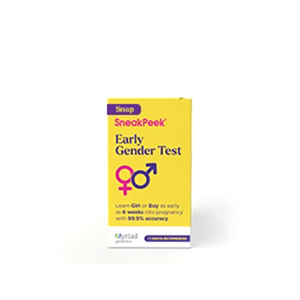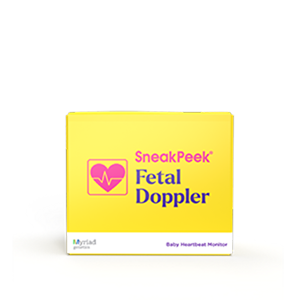Published on March 18th, 2022 and Updated on January 16th, 2024
Check out SneakPeek Gender Test to find out your baby’s gender as early as 6 weeks at over 99% accuracy1!
When your child arrives, get ready to go full heart-eyes. From baths to cuddles, you’ll want to shower her with every nourishing gift in the world. After all, how can you say no to that adorable little face? However, there’s one type of nourishment to pause over—water.
Water might be the elixir of life, but only from a certain age. Serve your baby water too early, and it might lead to an upset tummy, weight loss, and other health issues. This also rings true for questions like, “when can babies eat eggs?” or “when can babies eat meat?”
So, when can babies have water safely?
For most babies, you can safely introduce water around 6 months old—but there’s more to the story. Dive into our guide to learn all the baby hydration tips, tricks, and precautions you should know.
Infant Hydration: From Milk to Water
Humans are mammals—and that means we drink milk during infancy. Whether breastmilk or infant formula, miraculous milk delivers all the nutrients and hydration your baby needs during the first year of life.
So, when does water make a splash in your little one’s life?
According to the World Health Organization, most babies can start drinking water around 6 months old. Any earlier, and you risk reducing your baby’s intake of vital calories and nutrition. This is because your baby’s tummy is tiny. By filling some of that limited space with water, less room is left for nutrient-rich milk.
Keep in mind this rule only applies to serving your baby water on its own. If your baby is formula-fed, it’s safe to mix water into formula according to its preparation instructions (more on this later).
Let’s explore the timeline of a typical baby’s drinking habits for a clearer picture of when and how to introduce pure water.
0 to 6 Months Old
For the first 6 months, health professionals advise mothers to exclusively breastfeed or give their baby formula—no juice, no water, and no other liquids. Why?
In general, the dangers of water center around what it blocks more than what it provides. Giving your baby water before 6 months usually results in poor health for these reasons:
- Malnutrition – With almost zero jaw function and a teeny tiny stomach, your little bundle must get all of his nutrition from liquid calories—and every calorie counts. Water can steal precious stomach space from milk, robbing your baby of vital vitamins and nutrients and potentially leading to malnutrition or weight loss.
- Water intoxication – While rare, water intoxication is possible in babies (especially those under six months). Too much water can overload your baby’s immature kidneys, diluting crucial electrolytes in the bloodstream. If you notice symptoms like drowsiness, irritability, swelling, or seizures after water drinking, seek medical help immediately.
- Bacterial or viral infection – Think of your baby’s immune system like a new employee—it must train before working at full capacity. So, unless your drinking water is fully purified, your baby’s immune system—and in turn, your baby—is more susceptible to any pathogens or bacteria in the water.
Plus, unlike water or fruit juice, breastmilk and infant formula provides the nutrients necessary to support your baby’s health and development. In particular, breastmilk boasts:
- Macronutrients (including fats, proteins, and carbohydrates)
- Vitamins & minerals
- Antibodies for immune system support
- Hydration (with a content of 80% water)
For the first 6 months of life, your baby’s daily milk intake will increase from 12 ounces to 36 ounces or higher. Stick with strictly breastmilk or formula, and you’ll set your little princess on the right nutritional path.
6 Months to 12 Months Old
After 6 months, your baby can start consuming two new items—solid food and plain water. But don’t put down the baby bottle just yet.
From 6 to 12 months old, medical professionals advise slowly decreasing a small amount of your kid’s daily milk intake to 16 ounces or less. At the same time, solid food and water intake should increase to replace the calories, nutrients, and hydration lost from milk.
Aside from age, check for these physical signs that your little one can handle solid food and water, such as:
- Holding his head and neck up
- Sitting without support
- Mouthing or chewing on items
- Showing interest in food (open mouths, coo’s, etc.)
- Weighing about twice his birth weight
Does it seem like he’s ready for a sip? Start by giving him 2 to 4 ounces of water per day in a sippy cup. During this process, remember: every child develops at their own pace. If your baby resists water at 6 months, that’s ok! You can always try to introduce water again later.
One Year and Older
Your number one has made it to the big number “1”—yay! Now, it’s time to dive headfirst into daily water intake.
With your doctor’s approval and a healthy diet in place, your one-year-old can start leaving breastmilk or formula behind for pure water and solid food. From here, the American Academy of Pediatrics advises that kids drink an 8-ounce serving (one cup) of water per day, per year of age. This rule applies until your child reaches 8 years old—around the time when thirst can be self-regulated.
Choosing Safe Water for Your Baby
Unfiltered water can contain numerous pathogens and bacteria, some riskier than others to your baby’s developing immune system. Before giving your little one water (whether on its own or mixed with formula), consider one or more of these safe serving options:
- Filtered water – In developed countries, tap water is relatively safe for adults and babies (even with its fluoride levels). However, water supplies can become contaminated due to natural disasters, pipeline construction, agricultural runoff, and other major environmental changes. To block any lead or heavy contaminants, consider filtering your tap water with a filtration pitcher or faucet attachment before serving it to your baby. If you’re concerned about fluoride, don’t worry—many of these filters can remove that, as well. If you don’t want to filter your own water, though not as environmentally friendly, bottled water is a safe choice too, but make sure there’s little to no fluoride in it.
- Boiled water – Even after filtering, the American Academy of Pediatrics and US Food & Drug Association still recommends boiling any water you mix with formula, including bottled water. The boiling eliminates bacteria or viruses in the water, lowering its health risks for babies younger than 6 months. Once your little guy starts drinking plain water at around 6 months, you can choose whether to continue boiling it or not.
Concerned your little guy might’ve snuck water from an unclean source? Take him to a medical professional if you notice these waterborne illness symptoms:
- Diarrhea
- Vomiting
- Stomach cramps (indicated by clenched fists and an arched back)
- Low or no appetite
- Fever
Tips & Tricks for Introducing Water
She can sit up straight, grab her sippy cup, and even swallow some mushy banana. Yet, when it comes to sipping water, all you get is a face that says, “No way.”
Transitioning from flavorful milk to less-than-flavorful water can be tough—but it’s not impossible. The trick to introducing water is to make it as fun, appealing, and flavorful as possible.
Try these tips when hydrating your baby girl:
- Go small and frequent – If it’s your first time offering her plain water, start at a reasonable pace with small sips throughout the day. Your little one will stay hydrated without any uncomfortable bloat or fuss. Wondering when and how can babies have Pedialyte? Consult a healthcare professional for guidance on introducing additional fluids like Pedialyte, especially if your baby has specific hydration needs.
- Make it fun – Little sprinkles of merriment can turn drinking water into an exciting game. Choose sippy cups in bright colors, add eye-catching stickers, and use fun (and baby-safe) straws to heighten the experience.
- Serve in a bottle – By 6 months, your baby is probably familiar with sipping from a bottle. Rather than serving water in a sippy cup, you can choose to simply serve it via the same bottles! This familiar method can help calm any anxieties.
- Add flavor – You can add a little flavor to your baby’s water with natural, non-toxic ingredients. Fresh fruit slices or cucumber can jazz up plain water and turn it into a tasty treat for your little sipper.
Conditions That Impact Water Intake
As your child grows, a few factors might impact his individual water intake. Consider these physical and lifestyle factors when determining his water needs:
- Size and growth – Overnight growth spurts can impact all physical needs, including water intake. Similarly, research shows particularly small or large children might need to adjust their water intake accordingly. Consult a medical professional if you’re concerned that your child’s size impacts his hydration.
- Weather – Living in a high-altitude town or tropical environment? Dryness and excess warmth can impact your baby’s hydration levels, so consider outdoor time, especially in the summer heat. If the weather induces sweat, it’s best to add a little extra water to your child’s intake that day.
- Hydrating food intake – For adults, watery foods may not hugely impact their recommended 12 cups per day. For babies, though, high water content foods fill their tiny stomachs faster. Cucumber, watermelon, lettuce, and strawberries are just a few water-rich foods that may decrease water needs.
The introduction of water to a baby’s diet is a critical step that should ideally occur around six months of age, coinciding with the introduction of solid foods. This must be done cautiously, with considerations for the water’s safety, the baby’s readiness, and their individual needs due to growth, weather conditions, and the water content of the food they consume.
Sources:
- American Academy of Pediatrics. Choose Water for Healthy Hydration. https://www.healthychildren.org/English/healthy-living/nutrition/Pages/Choose-Water-for-Healthy-Hydration.aspx
- BMC Pregnancy & Childbirth. The relationship between water intake and fetal growth and preterm delivery in a prospective cohort study. https://bmcpregnancychildbirth.biomedcentral.com/articles/10.1186/1471-2393-10-48
- Healthline. 11 Benefits of Breastfeeding for Both Mom and Baby. https://www.healthline.com/health/breastfeeding/11-benefits-of-breastfeeding
- Healthline. When Should My Baby Drink Water? https://www.healthline.com/health/parenting/babies-drink-water
- John Hopkins Medicine. Feeding Guide for the First Year. https://www.hopkinsmedicine.org/health/wellness-and-prevention/feeding-guide-for-the-first-year
- Minnesota Department of Health. Safe Drinking Water For Your Baby
- Well Management Program. https://www.health.state.mn.us/communities/environment/water/wells/waterquality/safebaby.html
- Nemours Children’s Health. When Can My Baby Start Eating Solid Foods? https://kidshealth.org/en/parents/solid-foods.html
- Verywell Family. Should You Boil Water for Baby Formula? https://www.verywellfamily.com/preparing-baby-formula-2634688
- What to Expect. Preventing Waterborne Illness in Babies and Toddlers. https://www.whattoexpect.com/first-year/health-and-safety/preventing-water-borne-illness-in-kids/
- World Health Organization. Breastfeeding. https://www.who.int/news-room/questions-and-answers/item/breastfeeding

Shop Our Products
SneakPeek aims to provide the most accurate and up-to-date information to help our readers make informed decisions regarding their health before, during, and after pregnancy. This article was written based upon trusted scientific research studies and/or articles. Credible information sources for this article are cited and hyperlinked.





